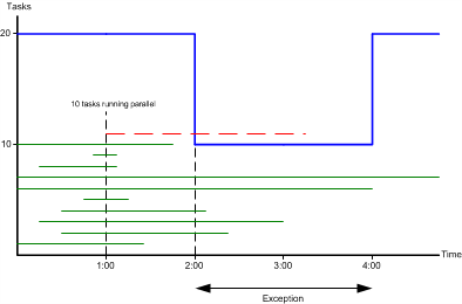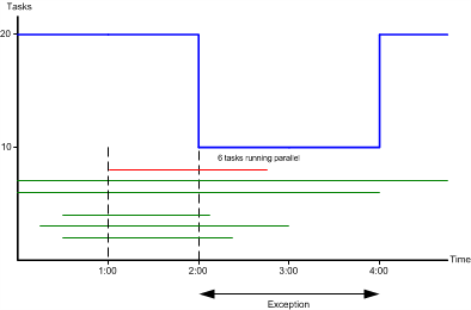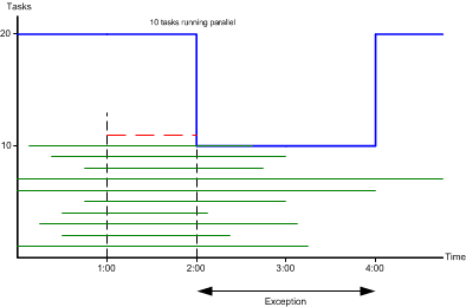
|
Documentation Tabs |

Queue |
Using Queue Objects |

|
This description provides more details about the Queue object setting "Consider Estimated Runtime for Calculation".
Also refer to the description of the Queue object's Attributes tab.
The term task limit refers to a Queue object's maximum number of tasks running parallel or its maximum slots.
Activating this option has the effect that the system checks whether the task limit of future exceptions would be exceeded before it executes a task assigned to the Queue object. This check includes the ERT (Estimated runtime) of the Queue object's tasks to be started and all those that are active at start time. A task is not started if the check proves that starting this task would result in the queue limits (max. slots) being exceeded at a later point in time.
If a queue's maximum number of parallel running tasks has already been reached or exceeded at an object's start time, the task changes to a waiting condition (status: Waiting for queue slot).
The following examples intend to explain this setting in more detail.
The following diagrams show the number of tasks via a time line. The green lines refer to the Queue object's active tasks. The beginning of a line indicates a tasks' start time. The length of the green line corresponds to the task's estimated runtime (ERT).
The blue line represents the queue's task limit. The maximum available queue slots are reduced from 20 to 10 due to an exception which occurs from 02:00 am to 04:00 am.
An object assigned to the Queue object is processed at 1:00 am (red line). At this point in time, the Queue object already includes 10 active tasks.

An ERT check of the object to be started shows that the task would still be active at the time the exception applies (2:00 am). Thus, the system determines the number of parallel running tasks that would still be active at this point in time. The ERT calculation of the Queue object's active tasks indicates that only 5 tasks will still be active at 2:00 am. Thus, the task can start.

Example 2 is similar to example 1. The green lines represent the active tasks of a Queue object. The blue line shows the course of the queue's task limit.
An object assigned to the Queue object is activated at 1:00 am (red line). An ERT check of all active tasks shows that no queue slots will be available at the exception time (2:00). Executing a new object would exceed the queue's maximum number of tasks running parallel. Thus, the task cannot start.

See also: